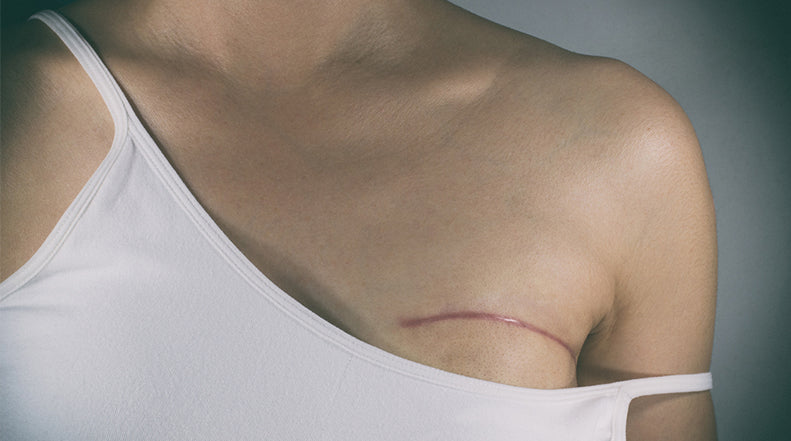How to Treat the 4 Most Common Types of Scars

Scarring is the body’s response to trauma and is a part of the natural healing process. The appearance of your scar and its treatment depend on multiple factors. According to WebMD, some of these factors include the depth and size of the wound, the location of the injury, and your personal characteristics, such as age, genes, sex, and ethnicity. Due to such factors, several types of scars can form after an injury. Below we are discussing 4 different types of scars as well as how to treat them.
RAISED SCARS
When skin is injured, the body produces a protein called collagen at the wound site to quickly mend and seal the wound. Unfortunately, when the body produces too much collagen, the result is a raised, discolored scar. Scars that rise above the surface of the skin can be further classified as either keloids or hypertrophic scars.
Keloid scars are raised scars that spread beyond the margins of the original wound and invade the surrounding normal skin. They often have a lumpy appearance and can be dark and red in color. Keloids may be inflamed, itchy, and painful, especially during their growth phase. The most common areas for keloids to form are in the earlobe after ear piercing, the deltoid after vaccination, and the sternum after acne, chickenpox, trauma, or surgery. Skin with darker pigmentation is more prone to keloid formation. Over time, a keloid scar may inhibit movement, and if left untreated they can continue to thicken and grow indefinitely. Treatments include surgery to remove the scar, intralesional steroid injections, or silicone sheets to flatten the scar. However, according to an article in the BMJ, simple surgical excision of keloid scars has a 50% to 80% risk of recurrence.
Hypertrophic scars are raised, red scars that are similar to keloids but do not go beyond the boundary of the injury. Hypertrophic scars are often inflamed, itchy, and even painful. They typically occur after burn injury on the trunk and extremities. Children and those with fair complexions and/or rosacea are especially prone to hypertrophic scarring. Current treatment options for hypertrophic scars include pressure garments, intralesional steroid injections, and silicone gel or silicone gel sheeting.
According to a 2016 publication by The Journal of Clinical and Aesthetic Dermatology, an algorithm for hypertrophic and keloid scar prevention and management has been developed by an international advisory panel and was recently updated. According to this algorithm, silicone-based products are preferred and currently recommended as the first-line option for preventing and treating excessive scarring after surgery or trauma.
SUNKEN SCARS
Sunken scars are known as atrophic scars. They are flat, depressed below the surrounding skin, and are often round with an indented or inverted center. Common causes of atrophic scars are acne scars and pockmarks. Unfortunately, no topical treatments are effective in raising sunken scars. Atrophic scars require treatments by a dermatologist, such as chemical peels, dermabrasion procedures, laser treatments, or even surgical excisions. Ideally, resolving wounds should be treated as early as possible before they sink, while they are still red. This is where silicone gel can help to prevent sunken scars. Silicone gel promotes healthy wound healing by providing the skin with proper hydration and an occlusive barrier to prevent bacterial infection.
BURN SCARS
If your skin has been burned, you may have one of three different kinds of scars: hypertrophic, keloid, or contracture. Contracture refers to the tightening of the skin after a second or third degree burn. As the affected area is healing, the surrounding skin pulls together, resulting in a contracture. This type of scarring must be treated as soon as possible because the contracture can result in restriction of movement around the injured area. Contracture scars may also go deeper, affecting muscles and nerves. The standard of care for a burn contracture typically involves surgical excision of the contracture and skin grafting. When it comes to keloids and hypertrophic scars after burn injuries the best treatment is silicone gel or silicone gel sheeting.
STRETCHED SCARS
Stretched scars, also known as striae distensae, are a type of scarring caused when the dermis (the middle layer of skin) is stretched during the healing process. There are two different types of stretch marks: striae rubrae and striae albae. Striae rubrae represent the acute stage of stretch marks, which appear as red and slightly raised lesions that are aligned perpendicular to the direction of skin tension. In contrast, the chronic stage of stretch marks (striae albae) appear as faded, wrinkled, and hypopigmented marks.
You most likely associate stretch marks with pregnancy, which is the most common cause of this type of scarring. Pregnancy stretch marks form during the last trimesters typically on the abdomen, but also commonly occurring on the breasts, thighs, hips, lower back and buttocks. However, any rapid stretching of the skin due to rapid growth or rapid weight changes can lead to stretch marks. For example, stretch marks may result from hormonal changes associated with puberty, bodybuilding, or hormone replacement therapy.
The most common method for treating stretched scars is the use of topical products. However, a 2016 review of the literature published by the Journal of the European Academy of Dermatology and Venereology found that there is no topical formulation which is shown to be most effective in eradicating or improving stretched scars.
HOW NEWGEL+ CAN HELP
We understand that all scars can be emotionally and physically distressing and believe that NewGel+ Silicone Gel products offer the best, most effective, non-invasive method to manage your scars. Click here to shop the widest variety of silicone gel products available to find the perfect solution for your unique scar needs.




Comments